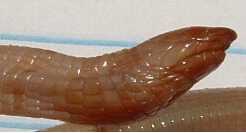Amphisbaenia
| Amphisbaenia | ||||||||||
|---|---|---|---|---|---|---|---|---|---|---|
 | ||||||||||
| Scientific classification | ||||||||||
| ||||||||||
| Families | ||||||||||
|
Amphisbaenidae (worm lizards) |
Amphisbaenia is a subgroup (suborder or infraorder) of the reptile order Squamata composed of peculiar, usually small and legless animals, known as worm lizards.
Extant (living) reptiles (Class Reptilia) are generally placed into four orders: Testudines (turtles), Rhynchocephalia (tuatara), Crocodilia (crocodilians) and Squamata (lizards, snakes, and worm lizards). Thus, worm lizards are distantly related to lizards and snakes, in spite of their resemblance to worms (due to their pink color and scales arranged in rings).
Although reptiles are tetrapods, meaning they are "four-legged" vertebrates, and worm lizards are usually legless, they are still considered tetrapods because it is assumed that they evolved from forms that did have appendages. The extraordinary diversity of nature complicates classification based on anatomical features; in general, taxonomy seeks for relationships based on common lineage.
Worm lizards are very poorly known, due to their burrowing lifestyle and general rarity. Only two species are known to exist in the United States, with most worm lizards being in Africa and South America.
Characteristics
Little is known of worm lizards outside of their anatomy, and even that is difficult to study due to the mechanics of dissecting something so small (most species are less than six inches long).
The head is stout, not set off from the neck, and either rounded, sloped, or sloped with a ridge down the middle. Most of the skull is solid bone, and they have a distinctive single median tooth in the upper jaw. They have no outer ears, and the eyes are deeply recessed and covered with skin and scales. The body is elongated, and the tail truncates in a manner that vaguely resembles the head. Their name is derived from Amphisbaena, a mythical serpent with a head at each end.
The skin of amphisbaenians is only loosely attached to the body, and they move using an accordion-like motion, in which the skin moves and the body seemingly just drags along behind it. Uniquely, they are also able to perform this motion in reverse, just as effectively.
Classification
Benton (2000) considers Amphisbaenia to be an infraorder within the Squamata Order, while considering the lizards (Lacertilia or Sauria) and snakes (Serpentes or Ophidia) to be orders. Uetz (2005) considers Amphisbaenia to be an suborder as with the lizards and snakes. (See reptile classification.)
Worm lizards are normally classified into three families:
- Family Amphisbaenidae (Worm Lizards)
- Family Trogonophidae (Shorthead Worm Lizards)
- Family Bipedidae (Two-legged Worm Lizards)
ReferencesISBN links support NWE through referral fees
- Benton, M. J. 2004. Vertebrate Paleontology, 3rd ed. Blackwell Science.
- Uetz, P. 2005. The EMBL Reptile Database. http://www.embl-heidelberg.de/~uetz/db-info/SpeciesStat.html
- Wu, X.C., D.B. Brinkman, A.P. Russell, Z.M. Dong, P.J. Currie, L.H. Hou, and G.H. Cui. 1993. ldest known amphisbaenian from the Upper Cretaceous of Chinese Inner Mongolia. Nature 366: 57-59.
Credits
New World Encyclopedia writers and editors rewrote and completed the Wikipedia article in accordance with New World Encyclopedia standards. This article abides by terms of the Creative Commons CC-by-sa 3.0 License (CC-by-sa), which may be used and disseminated with proper attribution. Credit is due under the terms of this license that can reference both the New World Encyclopedia contributors and the selfless volunteer contributors of the Wikimedia Foundation. To cite this article click here for a list of acceptable citing formats.The history of earlier contributions by wikipedians is accessible to researchers here:
The history of this article since it was imported to New World Encyclopedia:
Note: Some restrictions may apply to use of individual images which are separately licensed.